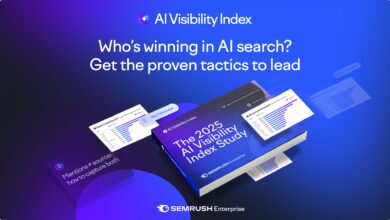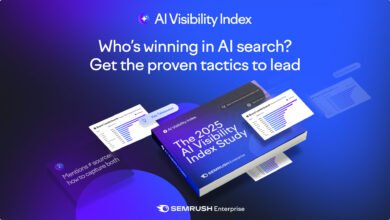GenAI Forces SEO to Shift From Tactics to Strategy

▼ Summary
– The article distinguishes between strategy as the overarching plan and tactics as the specific execution steps, emphasizing that confusing them leads to wasted resources and misaligned expectations in SEO.
– Historically, SEO has been viewed as tactical, with leadership setting strategic goals like growth from search and SEO teams implementing technical optimizations and content adjustments.
– Generative AI is reshaping SEO by introducing new strategic choices, such as competing for visibility across AI platforms, and new tactics like content chunking and retrieval testing.
– Misalignment between strategy and tactics in AI-driven SEO can result in missed opportunities, wasted budgets, and lost revenue, as tactical efforts without strategic direction lack focus and impact.
– The rise of AI automation is elevating the importance of strategic thinking in SEO, as tactical execution becomes commoditized, creating an opportunity for SEO professionals to lead on visibility and authority in new ecosystems.
The rise of generative AI is fundamentally reshaping how businesses approach search visibility, pushing SEO professionals to move beyond tactical execution and embrace a more strategic role. This shift isn’t just about adapting to new technology, it’s about redefining the value of search expertise in an AI-driven world where traditional methods are increasingly automated.
For years, the debate over whether SEO is strategic or tactical has simmered. Many practitioners view their work as strategic, while executives often see it as a set of tactical actions. The reality lies somewhere in between, but generative AI is forcing a clearer distinction. Strategy involves setting the direction, the plan, while tactics are the specific moves used to execute that plan. Confusing the two leads to wasted effort, unclear priorities, and missed opportunities.
Business leaders have long understood this distinction. Thinkers like Michael Porter emphasized that strategy means choosing the right race to run, the one you’re positioned to win. Henry Mintzberg noted that strategy isn’t just a plan but a starting point for action. Peter Drucker highlighted the importance of aligning strengths to make weaknesses irrelevant. In sales, strategy might mean focusing on enterprise accounts; tactics involve outreach sequences. In PR, strategy positions the brand as a leader; tactics include press releases and media pitches. SEO operates under the same principles.
Looking back, SEO’s evolution shows this dynamic clearly. In the early 2000s, strategy meant investing in Google visibility, with tactics like link building and directory submissions. When Google introduced Panda and Penguin, strategy shifted toward quality and sustainability, with tactics like content pruning and disavowing harmful links. The mobile era brought a strategic focus on meeting users where they were, executed through responsive design and site speed improvements. Later, BERT and passage indexing emphasized semantic relevance, with tactics evolving to include topic clusters and contextual optimization.
Generative AI changes everything by synthesizing answers instead of merely listing links. This transforms both strategic questions and tactical execution. Strategically, businesses must decide whether to compete across multiple AI platforms, prioritize authority signals, allocate budget to broad topics or niche areas, and invest in retrievability testing. Tactically, this involves structuring content into retrievable chunks, optimizing for semantic density, adding schema markup, and tracking citation frequency in AI responses.
It’s easy to mistake new tactics like chunking and embeddings for strategy, but they’re not. Strategy is deciding that GenAI visibility matters; tactics are the steps taken to achieve it. When these layers are misaligned, businesses face real costs: missed opportunities, lost revenue, wasted budgets, and eroded trust. Companies don’t usually fail because of poor tactics, they fail because tactics aren’t guided by strategy.
Historically, SEO has been viewed as tactical because it focused on execution, audits, optimizations, and publishing, while strategy was set elsewhere. But AI is automating many of these tactical tasks. Tools now generate meta descriptions, suggest keywords, and even create schema markup. This doesn’t make SEO irrelevant, it elevates its importance. As tactical execution becomes commoditized, the value shifts to strategy: defining visibility goals, building authority, and ensuring trust in AI-driven ecosystems.
Consider a financial services example: dominating “retirement planning for millennials” is a strategy; creating calculators and optimizing metadata are tactics. In sustainable investing, ensuring the brand is a trusted citation in AI answers about ESG funds is strategy; running retrieval checks and measuring citation frequency are tactics. One sets the direction; the other carries it out.
This distinction isn’t just semantic, it’s about influence and survival. SEO teams seen as tactical risk being underfunded and sidelined. Those perceived as strategic gain budget, resources, and a seat at the leadership table. Generative AI offers a rare opportunity for SEO professionals to redefine their role, moving from executors of optimizations to shapers of organizational visibility. Those who focus only on tactics risk being automated out; those who embrace strategy will lead in the new landscape.
For two decades, SEO excelled tactically in service of growth. Now, with machines taking over more execution, strategy becomes the defining frontier. The question is no longer whether SEO is strategic or tactical, it’s whether SEO professionals will step into the strategic role this new environment demands.
(Source: Search Engine Journal)





